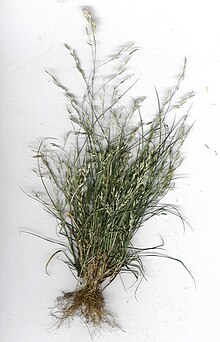Eragrostis
Eragrostis is a genus of herbaceous plants belonging to the Poaceae family. Most of its species, if they are given any use, is to feed to cattle.
Description
They are annual or perennial plants. Stems glabrous. Leaves frequently glandular, glabrous or setose, with ciliated sheaths in the area in contact with the blade; Blade flat, rolled around the edges or convoluted, furrowed and generally scabrous on the upper surface.
Inflorescence in a lax panicle. Laterally compressed spikelets, with numerous hermaphroditic flowers, with continuous and persistent rachilla. Glumes shorter than the flowers, subequal or unequal, uninervated, deciduous. Three-veined lemma, expires at maturity. Palea with 2 ciliate keels, persistent at maturity. truncated lodicules. Androecium with 3 stamens. Caryopsis sometimes furrowed, reddish, with an embryo of 1/2 of its length. Point thread.
Uses
However, Eragrostis tef is consumed by humans, mainly in Ethiopia. There is also evidence that E. clelandii and E. tremula have been eaten in Australia and Chad, respectively, in times of famine.
The seeds, which remain attached by means of small hooks to the hair or skin, are dispersed by animals.
Ecology
Some of the butterflies whose caterpillars feed on eragrostis include: Poanes zabulon.
Taxonomy
The genus was described by Nathanael Matthaeus von Wolf and published in 1776 in his Genera Plantarum / Vocabulis Characteristicis / Definita 23 (which is not Charles Linnaeus's Genera Plantarum ). The type species is: Eragrostis minor Host
- Etymology
Eragrostis: generic name derived from the Greek, eros (love) or era (earth) and agrostis (herb), probably alluding to the characteristic, earthy (human) scent of the female inflorescences of many of its species. Less descriptive are published interpretations that include gracefully dancing spikelets, quite a few spikelets, and "name meaning dubious".
- Cytology
The basic chromosome number of the genus is x = 10, with somatic chromosome numbers of 2n = 20, 40, 50, 60, 80, 100 and 108, since there are diploid and tetraploid species. Chromosomes are relatively small. The DNA content per haploid nucleus is 0.32 pg (reported for 1 species). Persistent nucleoli.
Species
- Eragrostis amabilis Kuntze
- Eragrostis ancashensis P. M. Peterson, Refulio et Tovar
- Eragrostis attentuta Hitchc.
- Eragrostis bahamensis Hitchc.
- Eragrostis barbata Trin.
- Eragrostis barrelieri Daveau
- Eragrostis boliviensis Jedwabn.
- Eragrostis brachypodon Hack.
- Eragrostis caesia Ekman et Mansf.
- Eragrostis calotheca Trin.
- Eragrostis chapelcea Jedwabn.
- Eragrostis caudata E. Fourn.
- Eragrostis cilianensis (All.) F. T. Hubbard
- Eragrostis ciliaris (L.) Link
- Eragrostis ciliaris (L.) R. Br.
- Eragrostis cubensis Hitchc.
- Eragrostis cumingii Steud.
- Eragrostis curvula Nees
- Eragrostis deflexa Hitchc.
- Eragrostis diversiflora Vasey
- Eragrostis elatior Hack.
- Eragrostis eriopoda Benth.
- Eragrostis erosa Scribn.
- Eragrostis excelsa Griseb.
- Eragrostis fendleriana Steud.
- Eragrostis floridana Hitchc.
- Eragrostis frankii C. A. Mey.
- Eragrostis hapalantha Trin.
- Eragrostis hosokai O. Deg.
- Eragrostis leptantha Trin.
- Eragrostis leptophylla Hitchc.
- Eragrostis lukwangulensis Pilg.
- Eragrostis macropoda Pilg.
- Eragrostis minor Host - scobilla de Cuba
- Neomexican eragrostis Vasey
- Eragrostis nigra Nees
- Eragrostis niihauensis Whitney
- Eragrostis orcuttiana Vasey
- Eragrostis orthoclada Hack.
- Eragrostis pallida Vasey
- Eragrostis palmeri S. Watson
- Eragrostis pectinacea
- Eragrostis perlaxa Keng
- Eragrostis pilgeri Fedde
- Eragrostis pilifera Scheele
- Eragrostis pilosa (L.) P. Beauv.
- Eragrostis plumbea Scribn.
- Eragrostis psammodes Trin.
- Eragrostis pusillus Scribn.
- Eragrostis reflexa Hack.
- Eragrostis reptans Nees
- Eragrostis redii Hack.
- Eragrostis simplex Scribn.
- Eragrostis tef Zucc. Trotter
- Eragrostis tenella Benth. 1817
- Eragrostis tracyi Hitchc.
- Eragrostis unionis Steud.
- Eragrostis variabilis Gaudich.
- Eragrostis whitneyi Fosberg
Contenido relacionado
Dirona
Danainae
Sicamino



